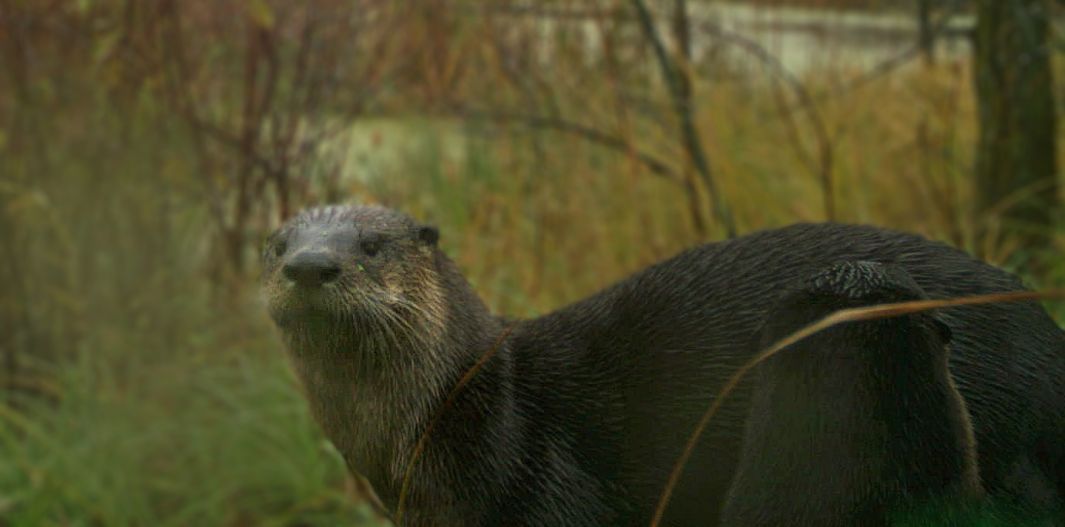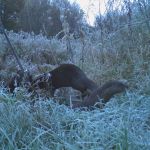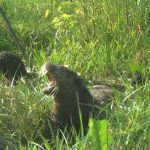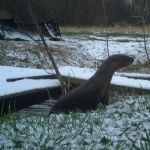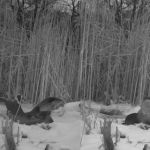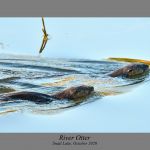Otter Spotter Project and Reporting
Report an otter sighting in our watershed
Quick Facts:
- River otters are indicators of water quality and habitat health.
- Otters need connected habitats that include healthy lakes, streams, and wetlands.
- A healthy otter population is present in the watershed. These otters successfully mate, raise young, and disperse.
- Otters in the watershed show a shift in behavior to be more active at night, which may be a way of avoiding human activity as much as possible in a largely developed area.
- Otters in the watershed have higher numbers and diversity of parasites (sampled in their scat) compared to a sample of rural otters, which may indicate implications to otter health in developed areas.
- For specific types of projects (e.g., meander construction, wetland and shoreline restorations, lake water quality improvement), otter monitoring is an effective tool in the toolbox for showing project success and improved habitat results.
Funding:
This effort was funded in part through a Ulysses S. Seal Conservation Grant with the Minnesota Zoo, an in-kind contribution from the University of Minnesota veterinary team, and an equipment loan from the Minnesota Department of Natural Resources.
Partners:
- Minnesota Zoo: Funder for field equipment and partnership in the field
- University of Minnesota Veterinarian Team: Preparation and support for live trapping
- University of Minnesota Veterinary Diagnostic Lab: Scat analysis, parasite identification, and expert advice on data interpretation
- Minnesota Department of Natural Resources: Permitting, guidance, and equipment loan
- Minnesota Trappers Association: Wildlife experts for live trapping
- The City of Vadnais Heights: Facility use
Reasons for the Project:
- Construction was planned to improve stream quality by building a meander on a previous straight-line ditch, along with pond reinforcement and flood control work.
- Monitoring of otter activity and use of the site was set up more than a year ahead of the project to allow monitoring that encompassed pre, during, and post construction otter use.
- While monitoring was ongoing, urban otter health and activity patterns were investigated compared to a similar rural site.
- University of Minnesota students, working with the watershed as part of their community-engaged learning experience, gained professional experience conducting conservation field-based techniques and sampling.
- Otters are charismatic, and people like learning about them.
Implementation:
A watershed-wide remote camera survey was conducted from 2018-2020 (click on the "Environmental Surveys and Biological Monitoring" drop-down). Early survey sites yielded photos of otters in the watershed. Focused monitoring efforts resulted from the remote camera survey. That monitoring included continuous remote camera monitoring at the Lambert Lake construction site and attempted live trapping during fall 2020. If an otter was successfully live trapped, it would have been surgically implanted with a transmitter and followed using radio telemetry to more accurately identify key habitat areas for protection and possible restoration. The live trapping effort was not successful. Ongoing remote camera monitoring continued through 2021, and the Otter Spotter reporting tool allows us to continue to rely on citizen scientists to help us understand otter activity in our watershed.
Results:
- Remote-camera data showed a behavioral shift toward more activity by otters at night at urban compared to rural sites (2018-2019)
- The Scat survey indicated higher presence and diversity of parasites at urban compared to rural sites (2020)
- Otters were documented mating, successfully raising young, and dispersing (young traveling on their own without their mom). These factors indicate healthy functional habitat for wildlife. Otters interactions were other species, including coyotes, also provide an interesting glimpses into day-to-day life for these animals.
- Otter activity at the construction site was shown to cease during construction, then return to slightly higher levels (timing and duration of visits) compared to pre construction. This showed that otters were not negatively affected by construction. They quickly returned and slightly increased use of the site once construction was completed.
- The photos are featured in a traveling photo exhibit that has been displayed at sites including the Ramsey County Library-White Bear Lake, Ramsey County Parks office headquarters, and the White Bear Lake Senior Center.
-
A video was produced by a local filmmaker to highlight the project as part of the Otter Tail River Walk that was held in 2021.
Links:
StoryMap: Includes Otter Spotter reporting
Reports: Click on the "Environmental Surveys and Biological Monitoring" drop-down
Video: Otter Spotters in the Watershed
Video: Trailcam adventures Part 1, Part 5

